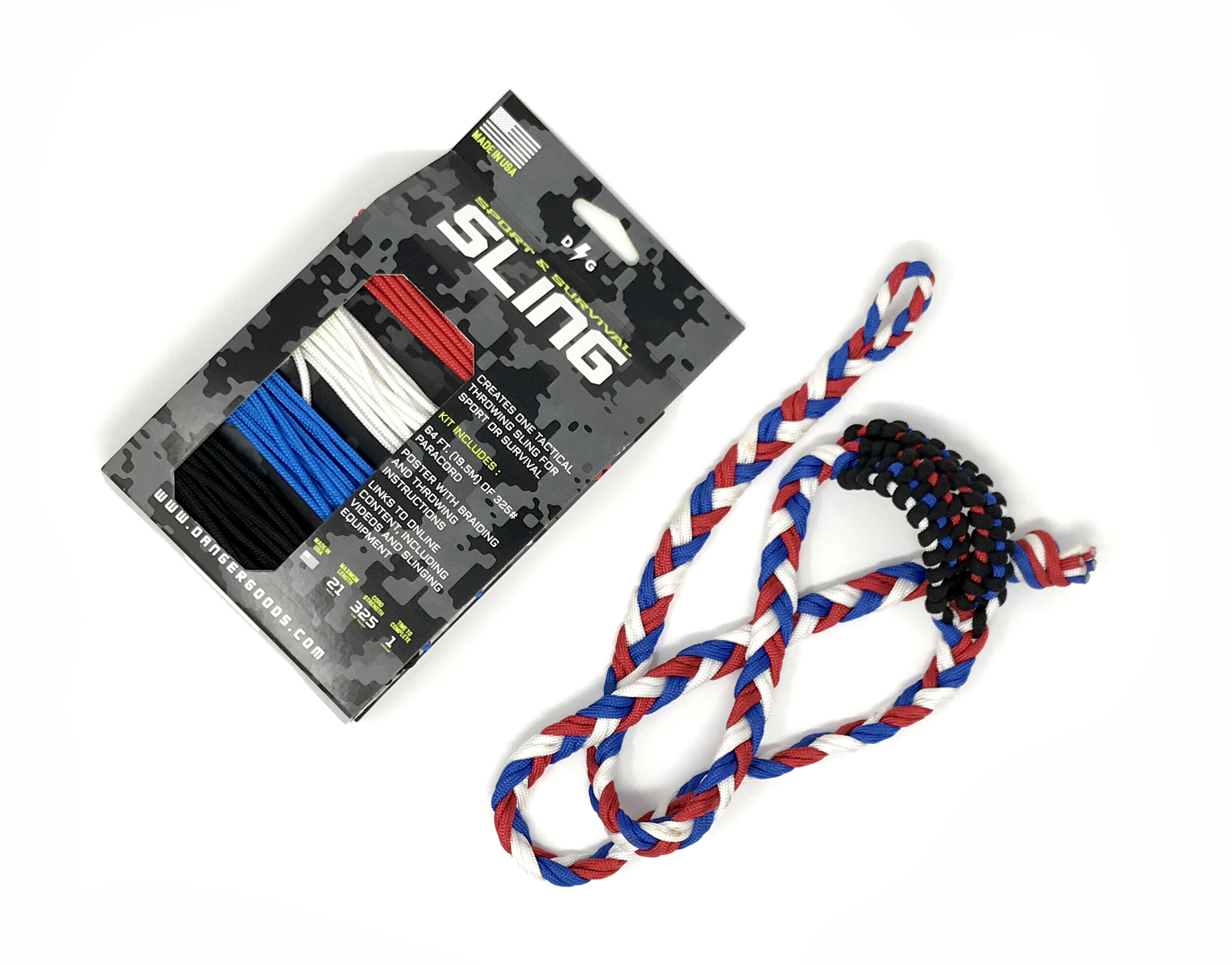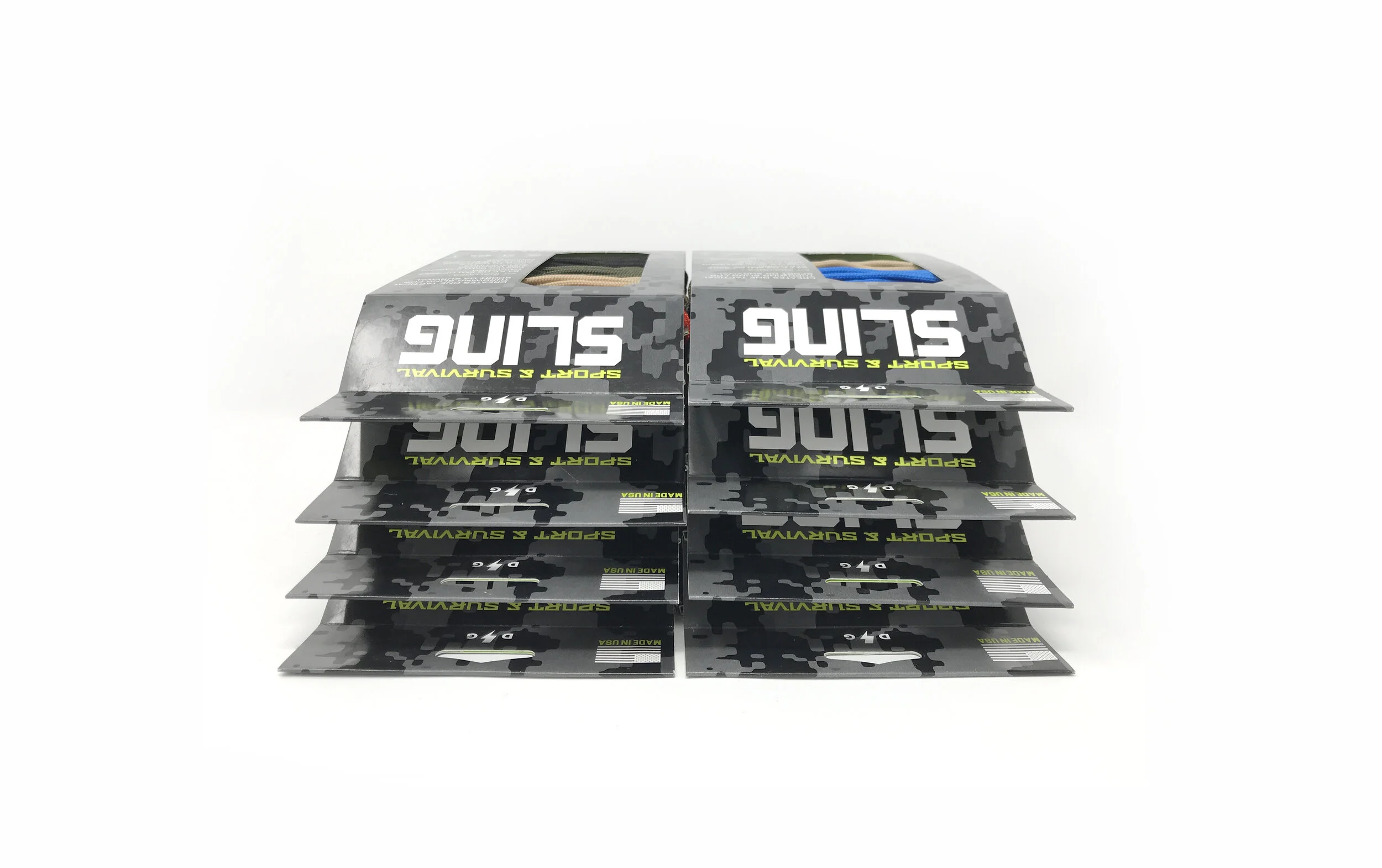Danger Goods Sling Kit
This user experience and packaging design project was intended to catalyze social change through a new product. It was developed in just weeks and brought to market quickly and inexpensively. These kits represent the first in a series of products that will be marketed under the name Danger Goods. This and supporting items are available at www.dangergoods.com.
Overview
Most of our projects showcase innovation, 2D and 3D design and development and design-for-manufacturing. This project demonstrates several of the capabilities we don’t often get to show, including: business and brand strategy, package design, and sourcing.
The output of this project also demonstrates that to be successful, an inventor need not take on the debt of developing and protecting a “million dollar idea.” A product that yields $10K/yr. can change the life of an inventor by providing valuable passive income, an exciting side hustle and the opportunity to grow the business into a full time job. By designing this product to require little upfront investment, we were able to bring it to market without incurring the debt typically associated with new product development.
Background
Danger Goods was formed in 2019 as a hub through which to bring simple, educational and empowering products to market that align with our ideals. The Danger Goods Sport and Sling Kit was developed to help reduce gun deaths in the U.S. from all sources, by reducing the overall number of guns — perhaps over generations. This project leveraged brand, experience and packaging design to create a product that, like methadone for America’s gun addiction, is designed to meet the psychological needs currently filled by guns with a less lethal alternative.
This project leverages many elements from our Modern Throwing Sling project. In that project, we used an obsolete projectile weapon — the throwing sling — to slow down the process by which a user would become proficient with a projectile weapon, thereby giving him/her the time to develop the maturity to use it responsibly. This project has the same Job to Be Done (JTBD) and leverages the same technology, but the product has been redesigned in a more empowering, emotional and educational embodiment. It was also designed to reduce the upfront cost (e.g. tooling) of bringing a new product to market — a hurdle that many inventors struggle with, particularly when creating a new market.
The Project
This project challenged the team to think of a product-based solution that could be implemented in parallel with regulatory initiatives to reduce gun deaths. During this project, the team:
performed preliminary research on which to base our design direction,
developed a hypothesis based on user insights,
designed a unique product / experience to meet the unstated needs currently fulfilled by firearms,
created a brand and brand collateral to provide a platform for this experience,
developed a package design,
sourced the product and package from U.S. vendors,
designed a simple assembly fixture to reduce production time,
began low volume production of finished units,
developed a website and e-commerce platform(s) for the finished product
In addition to the effect of the product itself, portions of all Danger Goods sales will be donated to Everytown for Gun Safety, an organization spearheading regulatory initiatives to curb gun violence. This project demonstrates the potential of a product to augment regulatory initiatives meant to improve society.
This project also demonstrates the power of a lean product development (PD) process to commercialize the ideas of inventors and startups on even the leanest budgets. Like the sling it produces, our lean PD methods provide leverage to those who employ it. In the case of this project, we took a controversial design prompt and a tiny budget and produced a product that can be manufactured inexpensively and domestically, sold profitably at low or high volume, and act as a catalyst for positive societal change.
Product Description
Materially, the product is simply a folded carton containing 64 ft. of paracord and a poster. The poster has an inspirational graphic on one side and educational information regarding the history, construction and use of the shepherd’s sling on the other. Armed with the sling itself, users can throw tennis balls at long distances to their dog, at a target, or in competition with others. Armed with the knowledge the kit contains, users are empowered to braid their own slings for themselves and others — with or without a kit — to catalyze the growth of slinging as an alternative precision sport in the U.S.
“The goal of this product is not to sell kits; it’s to catalyze the sport of target slinging in the U.S. ”
The Danger Goods Sling Kit is not just a product; it’s a catalyst. By starting the sport of slinging in the U.S. — the country with more gun-related deaths per capita than any developed nation in the world — Danger Goods hopes to create a community of athletes who value a precision sport that requires the skill, time and maturity of a martial art but lacks the power to contribute to mass casualties or suicide.







What does it do?
By extending the length of the thrower’s arm, the shepherd’s sling enhances the speed and distance with which a projectile can be thrown. Unlike other devices, such as bows or rifles, the sling is an active form of target weapon that enhances the natural throwing power of its user without the use of stored energy or aiming tools. In this way, slinging is perhaps the purest precision sport that uses assistive technology. A sling requires experience, not strength, to master, and it can be braided from any fiber by anyone with the most basic hand skills. As such, slinging is accessible to athletes of all ages, genders and financial means. Though slinging competition could be as nail-bitingly intense as that of Olympic archery, success will be determined not by the size of an athlete’s wallet but by the depth of her character.
Who Is It For?
“Precision and accuracy sports are sports whose objective is to hit a target of various shapes and sizes (such as a pocket, hole, jack or bowling pin) using various means (such as a bow, firearm, billiard cue, ball or club).”
The accessibility of slinging makes it an exciting activity for dog owners, target sport enthusiasts and survivalists alike. The simplicity of the kit makes it adaptable through simple graphic changes to package and poster. While future embodiments may be graphically designed to appeal to dog owners, campers, STEM programs and other groups, the first edition is aimed at target sportsmen and survivalists — the people most likely to advocate for the proliferation of firearms and to benefit from an alternative that provides the allure of a weapon-based target sport without the cost, lethality or regulation that typically accompany them.
% of Archers by category
Slinging is likely to naturally appeal most to target athletes, such as archers, who already gravitate to purer forms of target sport. According to the Archery Trade Association's 2013 Participation Report, there are over 18.9 million archers in the US alone. Of these, 55% participate in target archery alone, 35% participate in target archery and bowhunting, and just 10% participate in bowhunting exclusively. Like archery, there may be some who would be interested in a sling as a survival weapon alone, but this is likely to be a small (if not nonexistent) minority.
Appealing to target shooters who own guns for sport is a primary goal of this project. Gun ownership is woven into the identities of gun owners. Blanket regulations targeted at reducing the total number of available guns threaten the identities of the very voters needed to make that happen. If it can deliver on some of the emotional needs currently fulfilled by guns, the sling may — over a generation or two — make regulations possible which would be dead-on-arrival today.
Recreational Users
The sling provides a low cost, pocket-sized ball launcher for tennis and racquetballs. It stows easily in a pocket and can be used at the dog park to hurl tennis balls extreme distances. (More running = sleepier dogs!) Used on a disc golf course, the sling can form the foundation of an exciting new version of the sport. Because a single sling can be produced and loaded virtually for free, recreational slingers can enjoy much the same experience as disc golf at an even lower cost and without fear of losing an expensive disc in the woods.
Target Shooters
The list of target sports includes everything from olympic archery, biathlon, and riflery to bocce and darts. And target sports are addictive. Whether it’s an olympic bow or a bench rest rifle, the equipment associated with most target sports is often high tech and expensive — particularly for shooters, whose ammunition is both expensive and consumable. The sling offers the purest form of augmented target shooting at the lowest possible cost, making it almost universally accessible for all athletes and as potentially sticky as archery or other precision sports.
Survivalists
Even “minimalist” hunters rely on high tech and expensive equipment to pursue their quarry. Often this comes at great financial expense and with the loss of the purity of traditional hunting methods. Though this kit is not designed to produce a hunting sling, the knowledge a user will gain in completing it could be applied in a survival situation to produce a tool for small game hunting. As the sport of slinging grows, it is likely that target slingers who want to enjoy a pure form of hunting will petition states to add slinging to their list of approved weapons.















